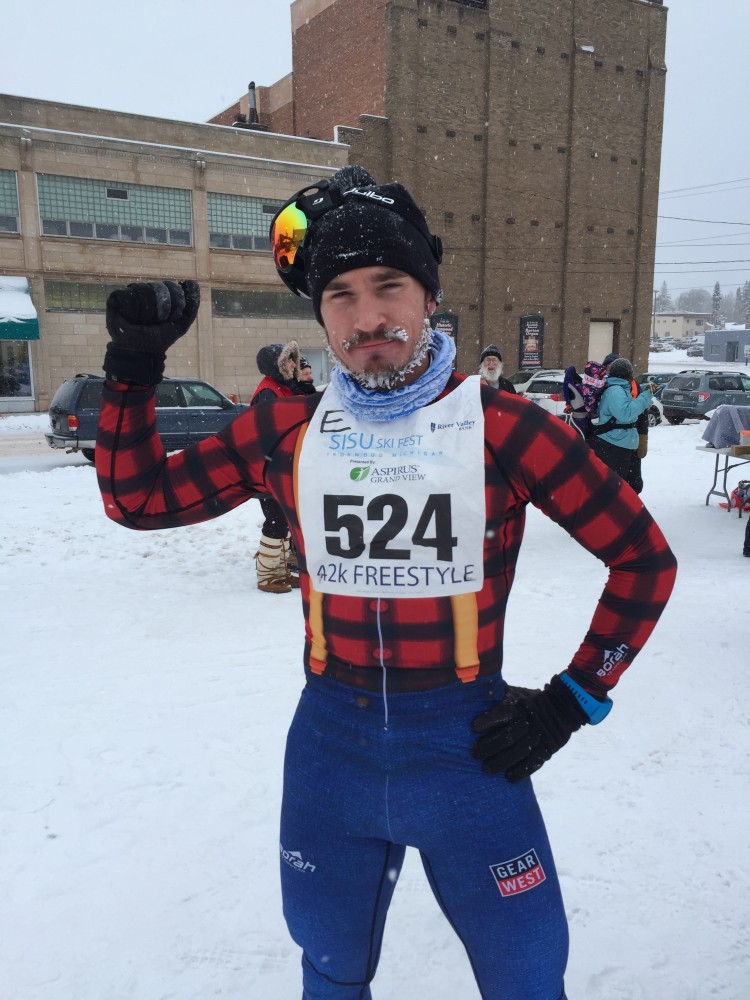
Nicknamed “The Dirty Thirty” by Drew Holbrook, FasterSkier’s featured Wednesday Workout for this week comes from Gear West/Salomon athlete Matt Liebsch, offering an end of summer/fall workout sure to boost speed and pain-cave stamina.
***
Dark, damp and delusory — the so-called pain cave is a place perhaps all too familiar with nordic-ski racers. But, at least according to Gear West and Salomon athlete Matt Liebsch, there is a place and time (30-second intervals to be exact) to test pushing past race pace.
“It hurts but one of my favorite workouts is nicknamed ‘The dirty thirty’ … Drew Holbrook came up with that name after his first attempt to complete the workout,” Liebsch, 33, wrote in an email.
The “Dirty Thirty” also known as 30/30s, is a Level 4/Level 5 rollerski workout, aimed at training above race-pace speed, but doing so within a short interval. By mixing the speed work with VO2max work, the end result is, as Liebsch indicated, a high-intensity interval training (HIIT) workout.

“This workout seems important when an athlete is bumping up against their ‘ceiling’; Lv3 speed is getting close to V02max speed,” Liebsch explained. “When you do a lot of distance and Lv3 work in the summer, threshold speed and V02max speed seem to get closer to each other… this workout will raise the speed ceiling at V02max allowing more room for growth in Lv3 speed. There is also a very important neuromuscular component to this workout… training the brain to fire muscles quickly is important.”
He recommends doing this workout two to three times a year, usually twice in the summer and once in the fall. Flat or gently rolling terrain is best, as anything too steep makes it difficult to reach max speeds during “on” time.
“It is a very taxing workout and usually the recovery period is 48-72hrs before you feel better,” Liebsch wrote. “I won’t complete this workout if I am feeling on the cusp of illness or if I am having [heart rate] suppression or general fatigue. The post workout recovery is important… just distance training for 3-4 days post session.”
Though Liebsch is not one to turn down a challenge, maintaining that “I love going fast and I love the ‘pain cave’, ” he also suggests that athletes be conscious of what their bodies are telling them prior to and during the Dirty Thirty workout.
“Going hard is fun and can make you faster but there needs to be a balance,” he wrote. “I see way too many masters and juniors going too fast in Lv1/Lv2 and not fast enough in their intensity sessions. The nice thing about the ‘dirty 30’ is once you complete the workout, you won’t feel like skiing too fast in your Lv1 training over the next few days.”

The Workout: Dirty 30 (or 30/30s)
Purpose: Train speed above race pace, while simultaneously taxing body for a short time period
Warmup: 15-20 minutes easy skiing with 5 x 10-second light speeds throughout
Liebsch says the point of the speeds during warmup are to “activate higher level energy systems.”
The set: 30 seconds of “on” time followed by 30 seconds of “off” time
Liebsch suggests 30 minutes of 30/30s for juniors and masters and 60 minutes of 30/30s for senior skiers
Cool down: 20 min: 10 minutes easy skiing followed by 5 minutes of 55 seconds “off” and 5 seconds “on” followed by and another easy 5 minutes
Total time: 1 hour 10 minutes – 1 hour 50 minutes skiing
Liebsch’s Top-Two Tips for the Dirty 30
- Body exertion, not exhaustion. “Caution!” Liebsch wrote. “Playing with fire can make you hot but it can burn you too. I have been on both sides of the fence with HIIT/Tabata and over-training as an athlete. There is a time and place for extremely taxing workload. Listen to your body, confer with a coach and be smart.”
- It’s a matter of mind AND matter. “As a rule of thumb, the first 6-8 minutes of this workout feel pretty good/easy, after that it starts to hurt,” he wrote. “Between 20-40mins the workout will feel unbearable at times… this is where mental fortitude comes into play. When I am ‘not feeling it’ I will cut the workout short, usually stopping around 45 min. If I am feeling good, I can continue up to the 1hr mark. The important thing is to stop this workout when the speed you are able to produce drops or when your technique falls apart. ”
Check out other adventures Liebsch has had this summer in the video below:
Haig Glacier from Maria Louise Berg on Vimeo.
Gabby Naranja
Gabby Naranja considers herself a true Mainer, having grown up in the northern most part of the state playing hockey and roofing houses with her five brothers. She graduated from Bates College where she ran cross-country, track, and nordic skied. She spent this past winter in Europe and is currently in Montana enjoying all that the U.S. northwest has to offer.



